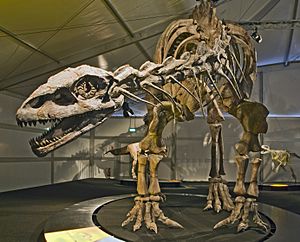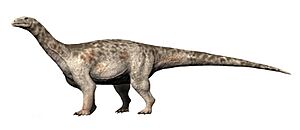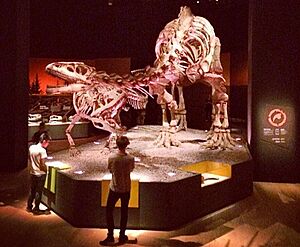Lessemsaurids facts for kids
Quick facts for kids Lessemsaurids |
|
|---|---|
 |
|
| Skeletal mount of Lessemsaurus | |
| Scientific classification |
|
| Kingdom: | Animalia |
| Phylum: | Chordata |
| Clade: | Dinosauria |
| Clade: | Saurischia |
| Suborder: | †Sauropodomorpha |
| Clade: | †Sauropoda |
| Clade: | †Lessemsauridae Apaldetti et al., 2018 |
| Genera | |
|
|
Lessemsauridae was a group of early long-necked dinosaurs. These amazing creatures lived during the Triassic and Jurassic periods. Their fossils have been found in Argentina and South Africa. They were some of the first really big plant-eating dinosaurs to roam the Earth.
Contents
Meet the Lessemsaurids!
Ingentia: The First Huge One
Ingentia was an early sauropod dinosaur. It lived during the Late Triassic period in Argentina. The name Ingentia prima means "first huge one." This is because it was one of the first very large sauropodomorphs to evolve. Its close relative, Lessemsaurus, was also one of these early giants.
Scientists found the first Ingentia fossil, called PVSJ 1086, in Argentina. Another fossil, PVSJ 1087, included parts of its tail, arm bones (radius and ulna), and a foot. These fossils help us learn how these giant dinosaurs grew.
Ledumahadi: A Giant Thunderclap
Ledumahadi means "a giant thunderclap" in the Sesotho language. This dinosaur was a sauropodomorph from the Early Jurassic period. It walked on four legs, like an elephant.
Ledumahadi was one of the first truly giant sauropodomorphs. It weighed around 12 tonnes (about 26,500 pounds)! That's like two large elephants. Even though it was huge, its legs were not yet like the thick, pillar-like legs of later giant sauropods.
Lessemsaurus: An Ancient Giant
| Lessemsaurus Temporal range: Upper Triassic, 228–208.5 mya
|
|
|---|---|
 |
|
| Scientific classification | |
| Kingdom: |
Animalia
|
| Class: | |
| Superorder: | |
| Order: | |
| Suborder: | |
| Genus: |
Lessemsaurus
|
Lessemsaurus was an extinct type of sauropod dinosaur. It lived during the Triassic period. What makes Lessemsaurus special is that it lived about 30 million years before famous long-necked dinosaurs like Diplodocus and Brachiosaurus.
The first Lessemsaurus fossil was found in Argentina. It was described by a scientist named José Bonaparte in 1999. This dinosaur was about 9 meters (30 feet) long. It lived around 210 million years ago.
Scientists like Steve Brusatte from the University of Edinburgh have studied these dinosaurs. He explained that lessemsaurids became huge on their own. They didn't need to evolve from the same ancestors as later giants like Brontosaurus and Diplodocus. This shows that different types of dinosaurs could grow to be enormous.



